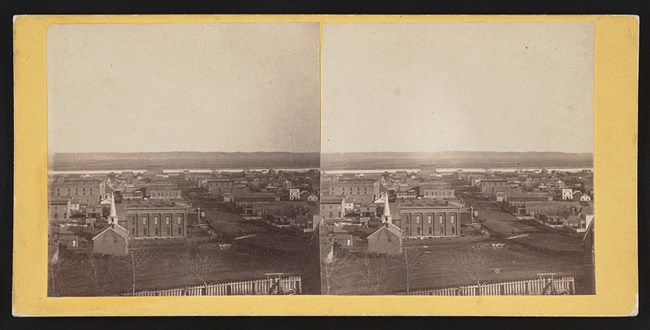Overview

Farnham Street Omaha from hill west of city. , None. [Between 1862 and 1868] Photograph. https://www.loc.gov/item/2018649838/.
Long before Omaha developed into the regional urban hub it is today, the land west of the Missouri River was occupied by numerous American Indian tribes. In Nebraska, one of these tribes is the U-Mo’n-Ho’n (Omaha), from which the city takes its name. In 1854, the U-Mo’n- Ho’n signed a treaty with the United States government relinquishing the rights to their land. In 1879, Omaha served as the backdrop for the MaNchu NaNzhiN (Chief Standing Bear) landmark legal case at the Fort Omaha Historic District.
A changing cast of diverse peoples have altered the site west of the Missouri River. Early settlers of southeastern Nebraska included fur traders, such as Lucien Fontenelle and Peter Sarpy. These settlers established trade with the American Indian tribes and gradually turned the Bellevue- Omaha area into a large trading post. Mormon pioneers traveling from Nauvoo, Illinois, to Salt Lake City in the Utah Territory spent the winter of 1846 and 1847 in what is now the Florence neighborhood of North Omaha. Although little of their winter quarters survive, they constructed a flour mill on the site of what later became Weber Mill, a facility that was in production well into the twentieth century and still stands today.
The Kansas-Nebraska Act of 1854 created the Nebraska Territory, and thousands flocked to the newly opened land. The founding of Omaha can be traced back to July 4, 1854. On this day, residents of Council Bluffs, Iowa, eager to create a commercial and transportation hub across the river from their town, celebrated with a picnic on what was later known as Capitol Hill, now the location of Omaha Central High School. Among those people was William D. Brown, founder of the Lone Tree Ferry Company in Council Bluffs, and the first person to imagine building a city on the land where Omaha sits today.
When the Union Pacific transcontinental railroad lines started in Omaha, ferries carried both travelers and freight across the Missouri. Council Bluffs boosters platted the frontier town across the river in 320 blocks. There were few permanent residents at first, but soon people put down roots and began to call Omaha home. Often people traveling to California and other western destinations decided to settle instead of moving onward, slowly populating the town. Several elements of these early days of Omaha can still be seen in the city. One of the first plots purchased in the town was bought by the Barker family in 1856 and is home to the Barker Building, constructed in 1929 by Peter Kiewit Construction, now a nationally recognized construction firm. Religion also was planted in the growing city; Nebraska’s Episcopal parish was founded in 1856, which was followed by the Trinity Cathedral which was constructed in 1883. St. Cecilia’s Cathedral, which began construction 1905, is a unique twin tower building that speaks to the pride of the Roman Catholics in Omaha and the Middle West.
Inspired by Chicago’s World Columbian Exposition of 1893, Omaha introduced itself to a national and international audience through the Trans-Mississippi and International Exposition in 1898. Omaha’s exposition celebrated both the city’s and the nation’s settlement of the western frontier. Although none of the grand buildings constructed for the Exposition survive, the event is commemorated by a historical marker in Kountze Park, which is situated on the former site of Omaha’s exposition, at 1920 Pinkney Street.
For any city to thrive, it needs to provide civic and urban improvements for its citizens. Omaha did just that with sewage system and road improvement projects well underway by 1885. Between 1885 and 1887, streetcar service was established and would see massive expansion in the coming years, leading to the annexation of several communities, including Benson and Florence. The Douglas County Courthouse continues to symbolize the growth of local government and includes the 1970s Omaha-Douglas Civic Center. The current library system which includes twelve locations was first established with the construction of the Omaha Public Library in 1894. Today, the original building has been re-purposed for use as office space. Finally, the Omaha Park and Boulevard System represents the city at its finest – through scenic parks and curving parkways, city officials sought to cure their citizens of perceived urban ills and to elevate the status of Omaha as compared to other major American cities at the time, including New York, Chicago, and Minneapolis.
All forms of art appreciated within the city, with plays and concerts performed at the Astro Theater. The Creighton (Orpheum) Theatre continues to serve as the center of Omaha’s performing arts scene and splits Omaha Performing Arts Broadway Season, with the modern Holland Arts Center, which is also home to the Omaha Symphony Orchestra and the Omaha Area Youth Orchestra. All these institutions have created a strong sense of culture and appreciation for all forms of art in Omaha.
Omaha grew from a small, impermanent settlement to a regional urban hub in a matter of a few decades. Today, nearly 470,000 people call Omaha proper their home, with a metro area of over one million.
You can find the historic properties under this Story – along with others throughout Omaha – by visiting the Travel Omaha, NE Map.
Historic Properties Related to Omaha's Growth
Last updated: April 5, 2023
